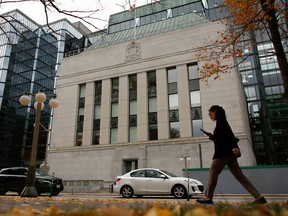Central bank held its benchmark interest rate steady at 5% for the second consecutive time
Article content
Bank of Canada governor Tiff Macklem says the runway for a soft landing is narrowing, but he does not believe the country is headed for a severe recession, even if moderating economic growth dips into negative territory in the coming quarters.
Macklem made the comments on Oct. 25, after the bank held its benchmark interest rate steady at five per cent for the second consecutive time.
Advertisement 2
Article content
Article content

“When people say the word recession, I think what they have in mind is a steep contraction in output and a large rise in employment. That’s not what we’re forecasting,” Macklem said. “We’ve been saying for some time that the path to a soft landing is narrow. And in this projection, that path has gotten narrower.”
The central bank now expects the economy to grow by 1.2 per cent this year, 0.9 per cent in 2024 and 2.5 per cent in 2025.
Still, Macklem noted that even with the near-term outlook affected by high oil prices and structural factors including a shortage of housing supply, the economy is forecast to return to higher growth by 2025, when the central bank also expects inflation to return to the target rate of two per cent.
Macklem pushed back on a suggestion the near-term forecast is reminiscent of “stagflation,” a term coined for a period in the 1970s when high inflation combined with an economic slowdown.
“That’s not a word I would use. I grew up in the 1970s,” he said at the news conference. “Stagflation to me is a period of high inflation and high unemployment. That’s not what we’re in now.”
Canada’s unemployment rate has remained steady at a historically low 5.5 per cent since July.
“(The Bank of Canada) is trying to walk a fine line fighting inflation without tipping the economy into a recession,” said Brooke Thackray, a research analyst at Horizons ETF Management. “Macklem may shift to a more dovish stance at the next meeting if the unemployment rate starts to move higher.”
Article content
Advertisement 3
Article content
At the Oct. 25 rate setting, the central bank said it was continuing its policy of quantitative tightening while recognizing that global bond yields are also working to tamp down demand.
“The global economy is slowing and growth is forecast to moderate further as past increases in policy rates and the recent surge in global bond yields weigh on demand,” the central bank said in a statement.
“In Canada, there is growing evidence that past interest rate increases are dampening economic activity and relieving price pressures.”
However, despite clearer signs that monetary policy is moderating spending and relieving price pressures, the central bank said it is concerned that progress towards price stability is slow and inflationary risks have increased, so it is prepared to raise the policy rate further if needed.
“Governing Council wants to see downward momentum in core inflation, and continues to be focused on the balance between demand and supply in the economy, inflation expectations, wage growth and corporate pricing behaviour,” the statement said.
The Bank of Canada noted that CPI inflation has been volatile in recent months — 2.8 per cent in June, four per cent in August and 3.8 per cent in September — amid higher interest rates that are moderating inflation in many goods that people buy on credit, a trend that is spreading to services.
Advertisement 4
Article content
And while food inflation is easing from very high rates, elevated mortgage interest costs and inflation in rent and other housing costs remain high.
“Near-term inflation expectations and corporate pricing behaviour are normalizing only gradually,” the central bank statement said, while wages are still growing a between four and five per cent.
“The bank’s preferred measures of core inflation show little downward momentum.”
In October, the central bank said CPI inflation is expected to average about 3.5 per cent through the middle of next year before gradually easing to two per cent in 2025. The Oct. 25 statement said getting inflation back to the target of two per cent will be more challenging in the near term due to energy prices and ongoing persistence in core inflation.
This ‘higher for longer’ approach on interest rates will likely delay investment decisions and pause new hiring. These are the factors that are making it start to feel like a recession for many businesses and households
Andrew DiCapua
Still, the Bank of Canada said domestic consumption has been “subdued,” with softer demand for housing, durable goods and many services. At the same time, weaker demand and higher borrowing costs are weighing on business investment, while the surge in Canada’s population is easing labour market pressures in some sectors while adding to housing demand and consumption.
Advertisement 5
Article content
“Overall, a range of indicators suggest that supply and demand in the economy are now approaching balance,” the central bank said.
Globally, GDP growth projections have changed little since July, the Bank of Canada said, though the composition has shifted with China weaker than expected and the United States economy proving stronger than anticipated.
Meanwhile, inflation has been easing in most economies as supply bottlenecks resolve and weaker demand relieves price pressures. However, underlying inflation is persisting and there are other changes since the summer including the war in Israel and Gaza, which the central bank called “a new source of geopolitical uncertainty.
Andrew DiCapua, a senior economist at the Canadian Chamber of Commerce said the rate hold and statements from the central bank are a clear signal that monetary policy is working to slow the Canadian economy, with interest rates at the highest level in two decades.
Related Stories
-

Why the Bank of Canada keeps misreading the economy
-

What economists say about the latest inflation numbers
However, he said the combination of a high cost of doing business and a high cost of living is starting to feel like a “perfect storm” that could lead to recession.
“Our latest analysis of Canadian business conditions shows that firms see inflation and costs as their top challenges,” DiCapua said in an email.
“That means this ‘higher for longer’ approach on interest rates will likely delay investment decisions and pause new hiring. These are the factors that are making it start to feel like a recession for many businesses and households.”
• Email: bshecter@postmedia.com
Bookmark our website and support our journalism: Don’t miss the business news you need to know — add financialpost.com to your bookmarks and sign up for our newsletters here.
Article content
Bank of Canada holds interest rate at 5% but more hikes on table
2023-10-25 14:00:16






Comments
Postmedia is committed to maintaining a lively but civil forum for discussion and encourage all readers to share their views on our articles. Comments may take up to an hour for moderation before appearing on the site. We ask you to keep your comments relevant and respectful. We have enabled email notifications—you will now receive an email if you receive a reply to your comment, there is an update to a comment thread you follow or if a user you follow comments. Visit our Community Guidelines for more information and details on how to adjust your email settings.